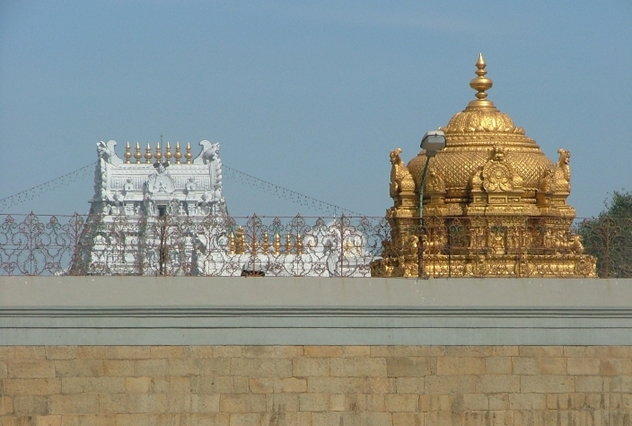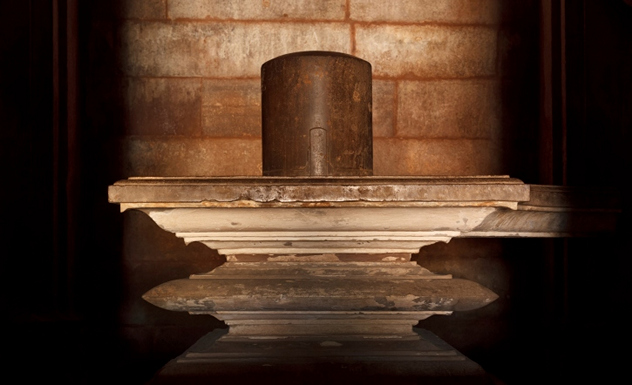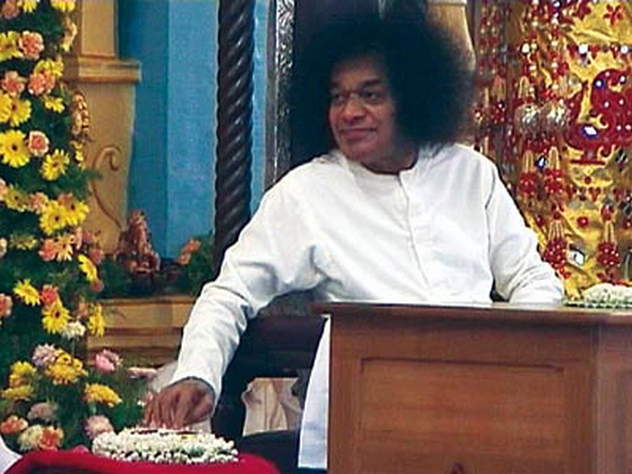 Weird Stuff
Weird Stuff  Weird Stuff
Weird Stuff  Health
Health Ten Confounding New Inventions from the World of Biomedicine
 Creepy
Creepy 10 Death Superstitions That Will Give You the Creeps
 Movies and TV
Movies and TV 10 Movies That Get Elite Jobs Right, According to Experts
 Weird Stuff
Weird Stuff 10 Times Real Laws Were Based on Bizarre Hypotheticals
 Animals
Animals 10 Inspiring Tales of Horses Being Human
 Mysteries
Mysteries Top 10 Haunting Facts About the Ghost Ship MV Alta
 History
History 10 Surprising Stories About the Texas Rangers
 Humans
Humans 10 Philosophers Who Were Driven Mad by Their Own Theories
 Miscellaneous
Miscellaneous 10 Video-Game-Worthy Weapons and Armors from History
 Weird Stuff
Weird Stuff 10 Warning Labels That Exist Because Someone Actually Tried It
 Health
Health Ten Confounding New Inventions from the World of Biomedicine
 Creepy
Creepy 10 Death Superstitions That Will Give You the Creeps
Who's Behind Listverse?

Jamie Frater
Head Editor
Jamie founded Listverse due to an insatiable desire to share fascinating, obscure, and bizarre facts. He has been a guest speaker on numerous national radio and television stations and is a five time published author.
More About Us Movies and TV
Movies and TV 10 Movies That Get Elite Jobs Right, According to Experts
 Weird Stuff
Weird Stuff 10 Times Real Laws Were Based on Bizarre Hypotheticals
 Animals
Animals 10 Inspiring Tales of Horses Being Human
 Mysteries
Mysteries Top 10 Haunting Facts About the Ghost Ship MV Alta
 History
History 10 Surprising Stories About the Texas Rangers
 Humans
Humans 10 Philosophers Who Were Driven Mad by Their Own Theories
 Miscellaneous
Miscellaneous 10 Video-Game-Worthy Weapons and Armors from History
10 Bizarre Cases Of Mysticism From India
India is a superstitious country, probably more strongly associated with mysticism than most other places on the planet. It’s the birthplace of many of the world’s oldest and biggest religions—notably Hinduism, which is practiced by 80 percent of the country’s population. Yet, with a billion people living there, it’s no surprise there are some unusual and notable practices. Here are some ways mysticism manifests itself in this fascinating South Asian republic.
10The Government’s Bizarre Gold Hunt

Swami Shobhan Sarkar was a man who had a dream. Not a dream in the Martin Luther King Jr sense. This was more “a dead prince told me about some hidden gold when I was asleep” sort of dream. The man in the dream was Ram Baksh Singh, who has been dead since 1857—he was hanged by the British for taking part in a rebellion. Yet Sarkar, a Hindu leader, claimed that Singh told him about 1,000 tons of gold hidden beneath the village of Daundia Khera. That’s about an eighth of the US federal reserve.
When a government minister, Charan Das Mahant, heard about the dream, he decided this was too good an opportunity to pass up. He sent representatives from the Geological Survey of India, followed by the Archaeological Survey of India (ASI). The geologists had apparently detected some sort of metal beneath the ground, so the archaeologists set to work digging two trenches. The whole thing became a media spectacle, with journalists joining locals to watch the dig unfold.
You will no doubt be shocked to learn that no gold was found. Among the things found in the first trench were some iron nails and three burnt brick walls. The second trench turned up “nothing but soil,” according to an ASI spokesman. It later transpired that the geological report had been tampered with. The geologists said they made no claim they had detected metal or recommended digging.
Many Indians are, naturally, frustrated at the dent to their reputation. India Today said the whole incident made the country look “like a clown.” The whole thing even triggered a copycat incident. This time, the dig was illegally carried out by another priest who got a tip in his dream. Unfortunately for him, the spot he chose for his bit of amateur archeology was a protected monument. The priest and five of his disciples were arrested after digging a 12-meter (40 ft) ditch. It seems that either dead people don’t really come to us in dreams to pass on information, or they’re just really keen on pranks.
9Temple Hair

Many places of worship rely on donations and offerings for their income. Yet there are some Indian temples that have cornered an unusual and lucrative market—selling human hair to the West. Many Hindus shave their head, as they consider giving up their hair to be an offering to Vishnu. India’s richest temple, the Venkateshwara Temple in Andhra Pradesh, takes advantage of this on an industrial scale.
In the temple there are two halls filled with barbers. They shave the hair from 12,000 pilgrims every day. That produces 75 tons of hair every year, which makes them $6.5 million. The hair is prized by many in the west, and a lot of it goes to Italian wig manufacturers. Short hair is sent to China, where the amino acid el-cystine is extracted for use as a food preservative.
8Shiva Lingam

Shiva is one of the most prominent gods of Hinduism. Since India is 80 percent Hindu, it’s no surprise that worship of Shiva is common. One of the most curious forms this takes is that of the Shiva lingam—essentially a representation of Shiva’s phallus. Followers create a stone pillar that is placed in a yoni, which is a representation of a vulva. The joining of Shiva’s “generative organ” with the yoni represents the source of all creation.
Worship of lingam stones has been ongoing for at least 2,400 years. While some dispute the phallic origin of lingam worship, most historians believe there’s a wealth of evidence in support. The oldest surviving example, the Gudimallam Shiva lingam, is topped with an extremely obvious glans.
Worship usually involves pouring a number of things onto the stone pillar. Milk and yogurt are often poured onto the tip (which does little to dispel the phallic link), as well as water, sugar, and other offerings. Not all lingam are manufactured. One of the most visited lingams is an ice stalagmite in a sacred site known as Amarnath Cave, which can receive 15,000 visitors in a single day. Yet in recent years, higher average temperatures around the cave have caused the lingam to shrink, and some are calling it a victim of climate change.
7Airplane Temple

Making an offering in a temple, or other place of worship, is pretty standard fare. Typically, people will give money, but there’s a Sikh temple (or gurdwara) in the Doaba region of Punjab that takes offerings of a different type—toy airplanes. It looks like a normal Sikh temple, all white and domed. The village that houses the temple has a cement model of a British Airways jet above its gate. Those offering prayers believe it’ll help them with visa applications to countries such as the US, the UK, and Canada. Settling overseas is a common goal for many people in the region, and there are currently 6 million people from Doaba settled abroad.
Rakesh Dixit, a scrap dealer from Delhi, has taken a different, but related approach to worship. He owns an Airbus A310, which used to fly for Air India. Rakesh is spending nearly $250,000 to convert the plane into a temple for Indian guru, Sai Baba. Dixit’s project got off to an awkward start, when the trailer carrying the plane’s fuselage tried to leave the airport on the back of a truck. Given that planes are quite long, the police had to order the driver to wait until midnight before he was allowed to leave, to prevent utter chaos.
6Evil Eye

The evil eye is a myth that is found around the world, but it’s taken quite seriously in many parts of India. Known as nazar, it comes from the idea that a gaze can cause harm. It’s said that offering praise, or even an admiring glance, can drain someone’s luck and energy. Mothers must be careful not to be too complimentary of their babies, for fear of drawing the evil eye. In order to help this, babies are given imperfections, in the form of a black mark made on the face, or a black thread tied around the arm.
The evil eye is said to be cast by those that may have reason to be jealous. Childless women looking with admiration at the children of others are casting the evil eye on the youngsters. Similarly, looking enviously at someone’s cow may cause the beast to stop producing milk and waste away. Those in poor health or circumstances may be said to cast the evil eye by looking at those that are better off.
The good news is that there are ways to protect oneself from the evil eye. Some shops sell nothing but talismans designed to ward the eye off. Often, people will hang up chilies, limes, and lemons as a homemade alternative. There are even places online that sell fruit-based wards to protect homes and offices against the evil eye, should you have a few rupees to spare and a desire to improve your lot.
5Ganges River

The Ganges is one of the most famous rivers on Earth. It also plays host to the world’s largest religious festival. The Maha Kumbh Mela is an event that takes place every 12 years, during which tens of millions of Hindus go for a dip in the water. Organizing a swim for that many people takes $290 million and requires 7,000 police officers. Most visitors are in the river for only seconds.
The river is said to cleanse bathers of sin. That is about the only part of a person that will leave cleaner than when they went in, as 3 billion liters of waste are dumped into the river every day. Domestic waste, industrial heavy metals, and the ashes of the dead form the biggest sources of pollution. Levels of human waste in popular bathing spots are up to 3,000 times acceptable levels. Having 100 million people plunge into the Ganges in a 55-day period doesn’t help—the festival causes a measurable increase in biological contamination.
4Satanism

According to the Vatican (who may be somewhat biased on these matters), kids in India are being seduced by Satanic cults. They claim 3,000 youths in the region of Nagaland are under the influence of the devil, and are using Facebook and Twitter to spread the cult. In April, the area’s Christian leaders held a “transformation crusade,” in an attempt to break the dark forces they believed were “wrecking societies, institutions, families and the hopes and cultures of generations with moral corruption.”
In another region of India, Mizoram, there have been reports of Bibles being burnt in churches. The books are placed on pictures of pentagrams within circles, before being set alight. A local Christian scholar blamed the influence of Western pop stars, who have offered themselves to Satan for fame and wealth.
One of the key practices of the Satanic youth is said to be Black Mass. Essentially a parody of Christian mass, it involves desecrating and stealing the sacred materials used in rituals by other religions. Churches in the Kerala region have had their tabernacles damaged and bread stolen. The local police have been less quick to blame the occult, stating that they think it’s a standard case of attempted theft.
3Sathya Sai Baba

Sathya Sai Baba was a famous guru—a very, very rich one. He claimed to be the reincarnation of Sai Baba of Shirdi, a guru who died in 1918. Sathya claimed to be able to perform miracles, though his critics claimed he could only perform magic tricks. Many people believed him; when he died in 2011, he left behind 50 million followers and an international empire worth $8.2 billion. He also left behind no heir, leading to quite a saga over who should take control of the fortune.
Sai Baba’s nephew, RJ Ratnakar, is among those claiming to be entitled to take over the fortune. Isaac Tigrett, co-founder of Hard Rock Cafe, claimed that he’d been given insight on the planned future of Sai Baba’s following. Members of the trust tasked with looking after Sai Baba’s ashram (the headquarters of the following), dismissed this claim out of hand.
The guru’s ashram, essentially a spiritual retreat that doubled as a headquarters, turned up another big surprise. When the Sai Baba’s private chambers were opened, they were found to be full of cash, gold, and silver. He had $2.4 million worth of rupees and hundreds of kilograms of precious metals. The police believe millions more may be hidden in secret vaults, and they even caught trustees trying to smuggle $75,000 worth of cash into a neighboring state. Since donations were supposed to be going towards good causes, many followers were left dismayed by the discovery of Sai Baba’s vast personal hoard.
2Margaret Thatcher

Margaret Thatcher isn’t generally known as a New Age mysticism sort of person. Yet India’s former foreign minister, K. Natwar Singh, reports on two unusual meetings between the former Prime Minister and an Indian tantric, known as Chandraswami. When the mystic was visiting the UK in 1975, he requested a meeting with Thatcher, who had recently been made leader of the Conservative Party. This was four years before she became Prime Minister, so she agreed to give him 10 minutes of her time.
Singh reports that Chandraswami asked Thatcher to write down five questions on strips of paper. He then crumpled them up, closed his eyes, and proceeded to offer accurate answers to all of them. Thatcher was so impressed that she requested another meeting. During their second encounter, Chandraswami made a few predictions—that Thatcher would be Prime Minister within four years and she’d be in power for nine, 11, or 13 years. She held the post for 11, ultimately.
Chandraswami has since fallen rather far from grace. He has been implicated in the assassination of the Indian Prime Minister, Rajiv Ghandi. He’s also been convicted of breaching laws on currency exchange. Either Chandraswami’s preternatural insight has failed him, or Singh’s story isn’t quite the whole truth. After all, it did come out when Singh had a book to sell, and got him some press coverage.
1Child Sacrifice

We’re not averse to covering the darker side of humanity at Listverse. We’re about to plunge straight into the depths of what we as a species are capable of. While superstition and magical thinking can be harmless, it can also persuade people to do things that can only be described as evil. If you tend to skip over the lists about murder, then you’ll probably want to skip the rest of this entry.
In India’s rural areas, belief in magic is pervasive. Witch doctors, or tantrics, travel among villages, dispensing their advice and practicing spells. Often, these are supposed to bring good fortune, or ward off black magic. Yet some of the rituals they perform, or get others to carry out, involve the mutilation and murder of children.
Akash Singh was a three-year-old boy from Barha, a village in Uttar Pradesh. A woman living in the same village was suffering from nightmares, so she turned to a traveling tantric for help. The tantric recommended sacrificing a child to the Hindu goddess of destruction. The woman kidnapped Akash, then, by turns, cut out his tongue, cut off his nose and ears, then cut off his fingers. He died slowly and painfully, and it was his mother that discovered his body.
Akash was far from an isolated case. Two men in Chhattisgarh state ritually sacrificed a seven-year-old girl, so they could use her liver as an offering. A witch doctor seeking good fortune beheaded an 11-year-old boy, so an offering could be made of his head. A woman, who had lost sons in infancy, turned to a tantric for advice on having a healthy child. The tantric beheaded a five-year-old girl in a field, following a series of prayers.
Seven people were arrested, when the bodies of two children—a two-year-old boy and an eight-year-old girl—were found in the house of a witch doctor. The police are digging for more, believing he’d been involved in other child sacrifices. In a case with a slightly happier ending, a policeman had two sisters, aged seven and four, tied up and ready for sacrifice. Luckily, the girls’ parents found them while they were still alive. In addition to child sacrifice, there are also 200 women killed every year for being witches.
There are people that dedicate their lives to combating the superstition and ignorance that leads to such horror, but they don’t have it easy. Prominent rationalists have been murdered and exiled. One state in India has banned the practice of black magic, which is a start. But with much of India’s rural population relatively isolated, and their beliefs so entrenched, there will be many more victims before these things can be confined to history.
All of Alan’s list ideas are given to him in his dreams by a 19th century Indian prince. You can email him here.








